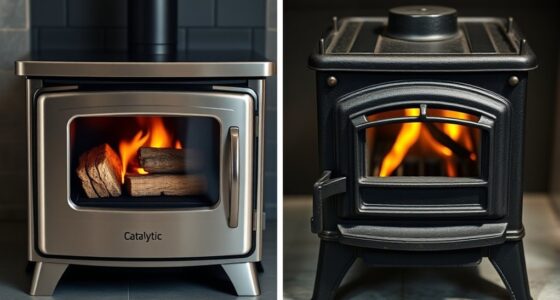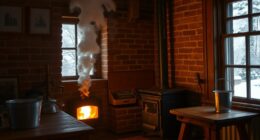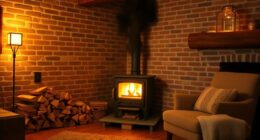A stove is a standalone unit that requires its own venting system, often involving new chimney installation, making it more costly and flexible for space. In contrast, a fireplace insert fits into an existing masonry fireplace or opening, usually with less extensive venting and lower installation costs, especially if the chimney is in good shape. Your choice depends on your setup and needs—stick around to discover which option best fits your home and budget.
Key Takeaways
- Stoves are standalone units that require new venting, while fireplace inserts fit into existing fireplaces with minimal venting modifications.
- Inserts are more cost-effective and easier to install if a chimney is already available, whereas stoves often involve higher installation costs.
- Fireplace inserts upgrade existing masonry fireplaces, providing a quick and efficient heating solution, unlike stoves which are built from scratch.
- Proper venting and professional installation are essential for both to ensure safety, safety, and optimal heating performance.
- The choice depends on home infrastructure, with inserts suited for existing fireplaces and stoves for new or flexible heating needs.

When it comes to heating your home, understanding the key differences between a stove and a fireplace insert can help you make an informed choice. Both options are excellent for adding warmth and ambiance, but they differ markedly in how they operate, install, and fit into your living space. One of the first considerations is ventilation requirements. Stoves, whether wood-burning, pellet, or gas, typically need a dedicated venting system—like a chimney or vent pipe—to safely expel smoke, gases, and other byproducts. These venting systems are usually installed outside the home and are designed to handle the specific exhaust needs of the stove, guaranteeing safe operation. Fireplace inserts, on the other hand, are designed to fit into an existing masonry fireplace or a prepared opening. Since they are built to be inserted into an existing structure, their ventilation requirements are often less extensive, but proper chimney or venting is still essential to guarantee safe operation and prevent smoke or dangerous gases from entering your living space.
Installation costs are another vital aspect to consider. Stoves generally involve higher installation costs because they require a new venting system, clearances, and sometimes modifications to the space to accommodate the unit. The installation process can include running new chimneys or vent pipes, which can be labor-intensive and costly depending on your home’s layout. Fireplace inserts tend to be more cost-effective in this area because they utilize the existing fireplace structure. If your home already has a functioning chimney, installing an insert can markedly reduce installation time and costs. However, if your chimney needs repairs or modifications to meet safety standards, those expenses will add up. In both cases, professional installation is highly recommended to guarantee safety and efficiency, but the overall costs can vary considerably based on your home’s setup and the type of unit you choose.
Ultimately, your decision should depend on your existing infrastructure, budget, and heating needs. If you already have a functioning fireplace and want a straightforward upgrade, an insert might be the more economical and less invasive option. If you’re building from scratch or need a more adaptable heating solution that doesn’t rely on an existing chimney, a stove might be better despite its higher upfront installation costs. Keep in mind that proper ventilation isn’t just a matter of safety but also impacts your home’s air quality and heating efficiency. Carefully weighing these factors will help you select the best heating solution for your home, guaranteeing comfort, safety, and cost-effectiveness in the long run.
Frequently Asked Questions
Can a Stove Be Installed in Any Room?
You can install a stove in many rooms, but you should consider alternative installation locations and room size considerations first. Small or poorly ventilated spaces might not be suitable, so verify there’s proper airflow and clearance. Check local codes and manufacturer guidelines to confirm safety and efficiency. With proper planning, a stove can be a cozy addition to various rooms, enhancing warmth and ambiance where you need it most.
Do Fireplace Inserts Require a Chimney?
Did you know that about 80% of fireplace inserts need a chimney or venting system? Fireplace inserts generally do require a chimney or venting options to guarantee proper ventilation requirements are met. This helps prevent smoke buildup and ensures safe operation. If your home already has a chimney, installing an insert is usually straightforward. Without proper venting, you risk inefficient heating and potential safety hazards, so check your venting options carefully before installation.
Are Stove and Fireplace Insert Emissions Environmentally Friendly?
Stoves and fireplace inserts can be environmentally friendly if they meet strict emission standards, helping improve air quality. Modern models often feature advanced burning technology that reduces harmful emissions, making them a cleaner heating option. By choosing EPA-certified products, you guarantee lower emissions and better air quality in your home and community. Always check product labels and maintain your appliance properly to keep emissions minimal and environmentally friendly.
Which Option Is More Energy-Efficient: Stove or Fireplace Insert?
A fireplace insert is generally more energy-efficient than a stove, saving you about 30% on energy bills. You’ll notice better heat retention and more consistent warmth with an insert, which leads to significant energy savings. When comparing costs, fireplace inserts tend to have a higher upfront cost but offer lower long-term energy expenses. So, if efficiency matters most, an insert is your best choice for reducing energy use and costs.
What Maintenance Is Needed for Each Heating Appliance?
You need to regularly clean and service both appliances to guarantee safety and efficiency. For stoves, check ventilation requirements, clean the ash or soot, and inspect seals and components periodically. Fireplace inserts also require cleaning of the glass and combustion chamber, along with professional servicing to maintain proper ventilation. Always follow manufacturer instructions and schedule professional inspections annually to prevent hazards and keep your heating system running smoothly.
Conclusion
So, now you see the key differences between a stove and a fireplace insert. Whether you prefer the portability and variety of stoves or the seamless integration of inserts, it’s all about what suits your home and lifestyle best. Think about your heating needs and style preferences—are you really ready to choose the option that keeps your space cozy and efficient? Whichever you pick, you’re making a warm, smart decision.










